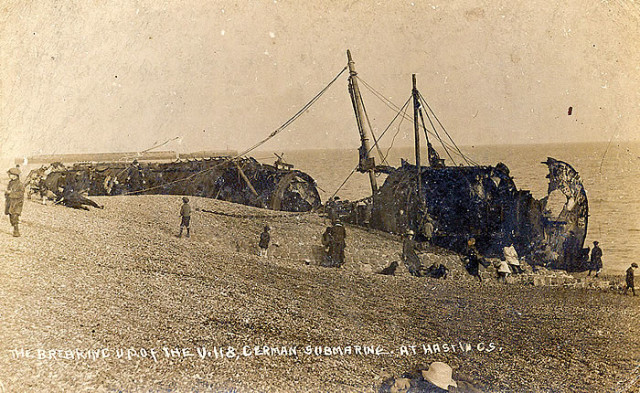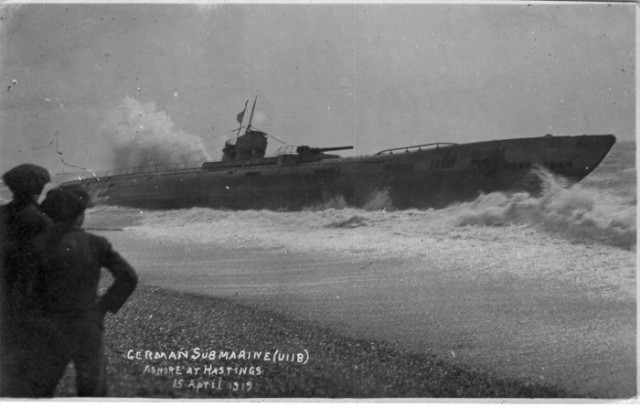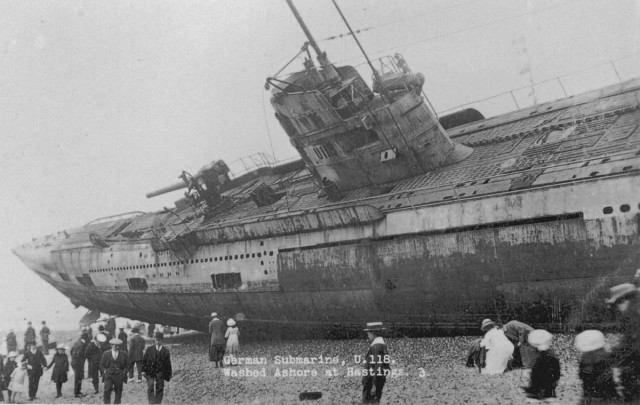WE ARE ALL CHILDREN OF GOD!
That time in 1919 a WWI German U boat washed ashore on a British Beach and ruined ” seaside day” for everyone

| SHARE:FacebookTwitter |

SM U-118 was a type UE II minelaying submarine of the Imperial German Navy and one of 329 submarines serving with that navy during World War I. U-118 was engaged in naval warfare and took part in the First Battle of the Atlantic.The SM U-118 was commissioned on the 8th of May 1918, following her construction at the AG Vulcan Stettin shipyard in Hamburg. She was commanded by Herbert Stohwasser and joined the I Flotilla operating in the eastern Atlantic. After four months without sinking any ships, on the 16th September 1918, the SM U-118 scored her first hit. Some 175 miles (282 km) north-west of Cape Villano, the U-118 torpedoed and sank the British steamer, Wellington. The following month, on the 2nd October 1918, she sank her second and last ship, the British tanker Arca at about 40 miles (64 km) north-west of Tory Island. The ending of hostilities on the 11th November 1918 led to the subsequent surrender of the Imperial German Navy. The SM U-118 was transferred to France on the 23rd February 1919.

U-118 was to be broken up for scrap. In the early hours of 15th April 1919, however, while she was being towed through the English Channel towards Scapa Flow, the dragging hawser broke off in a storm. The submarine ran aground on the beach at Hastings in Sussex at approximately 00:45, directly in front of the Queens Hotel.

Initially, there were attempts to displace the stricken vessel. Three tractors tried to refloat the submarine, and a French destroyer attempted to break the ship apart using her guns. All were unsuccessful, and the closeness of the submarine to the public beach and the Queens Hotel prevented the use of explosives.

The stranded submarine became a popular tourist attraction, and thousands visited Hastings that Easter to see her. She was under the authority of the local coast guard station, and the Admiralty allowed the Town Clerk of Hastings to charge a small fee for visitors to climb on the deck. This went on for two weeks, during which the town gained almost £300 (UK£ 13,200 in 2016) to help fund a welcome for the town’s soldiers returning from the war.


Two members of the coast guard, chief boatman William Heard and chief officer W. Moore, showed important visitors around the interior of the submarine. The visits were curtailed in late April when both coast guard men became severely ill. Rotting food on board was thought to be the cause, however, the men’s condition continued and got worse. Moore died in December 1919, followed by Heard in February 1920. An inquest decided that a noxious gas, possibly chlorine released from the submarine’s damaged batteries, had caused abscesses on the men’s lungs and brain.

Although visits inside the submarine had stopped, tourists still came to take be photographed alongside or on the U-boat’s deck. Finally, between October and December 1919, the U-118 was broken up and sold for scrap.The deck gun was left behind but was removed in 1921. Some of the ship’s keel may yet remain buried in the beach sand.

